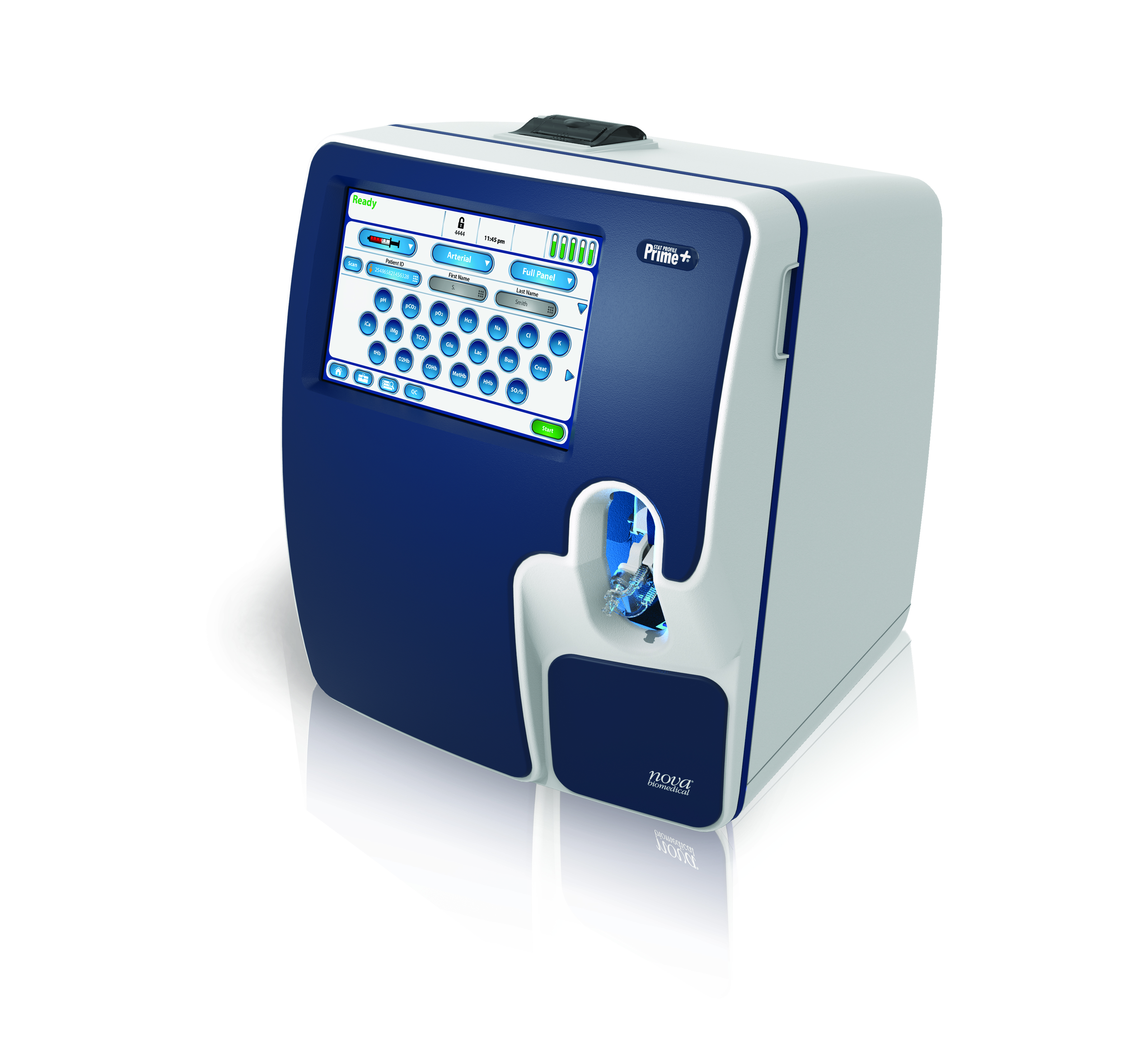Waltham, MA – Nova Biomedical announces the addition of a key new test to its Stat Profile Prime Plus critical care analyzer—the ability to calculate and report estimated plasma volume (ePV), a very important test for critically ill patients but one that has been very difficult to obtain. The plasma volume status of a patient is one of the top priorities in evaluating and treating many different conditions including, shock, sepsis, congestive heart failure, acute or chronic kidney disease, chronic pulmonary disease, as well as general postoperative care.
Background
Plasma volume is the amount of intravascular fluid minus red blood cells, white blood cells, and platelets. Timely, accurate measurement of plasma volume or overall volume status has been notoriously difficult if not impossible. [1] Thus, many surrogates for volume status have been developed over the years, from simple non-invasive measures such as patient history and physical examination, weight, laboratory studies, and radiographic imaging, to more complex and invasive techniques such as CVP or pulmonary capillary wedge pressure measurement. More recently other non-invasive or minimally invasive techniques have been developed but they are costly, cumbersome and cannot be adapted to the most important clinical need– serial measurements over time.
Estimated Plasma Volume Calculation (the Strauss Equation):
Several formulas based on hemoglobin, hematocrit, and sometimes weight were developed decades ago [2,3], and have recently been studied in various patient populations with some promising results. [4-6] One of the more commonly used formulas is the Strauss equation [3], which requires measured hemoglobin and measured hematocrit to determine ePV. Calculated hematocrit or hemoglobin can produce inaccurate results in patients who have abnormal red blood cell size and patients who are experiencing rapid fluid shifts. Elevated ePV has been shown to be an independent predictor of all-cause mortality [7]. ePV seems to be most beneficial when it is measured serially, and thus the change in plasma volume (ΔPV) can be gauged. This has been shown to have prognostic ability in patients with heart failure [4, 6, 8] and there is intense interest in its usefulness in sepsis, dialysis, postoperative care, dengue, and other conditions [9].
The Stat Profile Prime Plus analyzer has both measured hemoglobin and measured hematocrit (along with blood gases, electrolytes, metabolites, and co-oximetry), and is uniquely capable of reporting ePV using the Strauss equation. The Prime Plus performs the Strauss ePV calculation and provides both trend data and delta values. With the addition of ePV, Prime Plus now helps clinicians assess patient intravascular volume, acid base balance, blood oxygenation, oxygen carrying capacity of blood, tissue hypoxia, electrolyte balance, kidney function, and glucose control in one minute from two drops of blood.
About Nova Biomedical
Incorporated in 1976 and based in Waltham, MA, Nova Biomedical is a world leader in the development and manufacturing of whole blood, point-of-care and critical care analyzers, as well as instruments for cell culture monitoring in the biotechnology market. Nova uses biosensor technology in products ranging from handheld meters for glucose self- and point-of-care testing to critical care whole blood analyzers designed for stat measurement of over 22 analytes. Nova’s BioProfile line has pioneered comprehensive cell culture testing, providing over 20 critical cell culture tests for broad range of cell culture applications. Nova employs over 1,300 people worldwide and has wholly owned subsidiaries located in Brazil, Canada, Great Britain, France, Spain, Italy, Germany, Switzerland, and Japan. Certified by the International Organization for Standardization, Nova has manufacturing operations located in the U.S. and Taiwan.
1. Kalantari, K., et al., Assessment of intravascular volume status and volume responsiveness incritically ill patients. Kidney Int, 2013. 83(6): p. 1017‐28.
2. Dill, D.B. and D.L. Costill, Calculation of percentage changes in volumes of blood, plasma, and redcells in dehydration. J Appl Physiol, 1974. 37(2): p. 247‐8.
3. Strauss, M.B., et al., Water diuresis produced during recumbency by the intravenous infusion ofisotonic saline solution. The Journal of clinical investigation, 1951. 30(8): p. 862‐868.
4. Duarte, K., et al., Prognostic Value of Estimated Plasma Volume in Heart Failure. JACC Heart Fail,2015. 3(11): p. 886‐93.
5. Huang, C.Y., et al., Long‐term Prognostic Value of Estimated Plasma Volume in Heart Failure withPreserved Ejection Fraction. Sci Rep, 2019. 9(1): p. 14369.
6. Kobayashi, M., et al., Prognostic value of estimated plasma volume in acute heart failure in threecohort studies. Clin Res Cardiol, 2019. 108(5): p. 549‐561.
7. Marawan, A. and R. Qayyum, Estimated plasma volume and mortality: analysis from NHANES1999‐2014. Clin Res Cardiol, 2020. 109(9): p. 1148‐1154.
8. Kobayashi, M., et al., Prognostic impact of plasma volume estimated from hemoglobin andhematocrit in heart failure with preserved ejection fraction. Clin Res Cardiol, 2020.
9. Gertz, Z.M., et al., Implications of Left Ventricular Geometry in Low‐Flow Aortic Stenosis: APARTNER 2 Trial Subanalysis. JACC Cardiovasc Imaging, 2019. 12(2): p. 367‐368.


